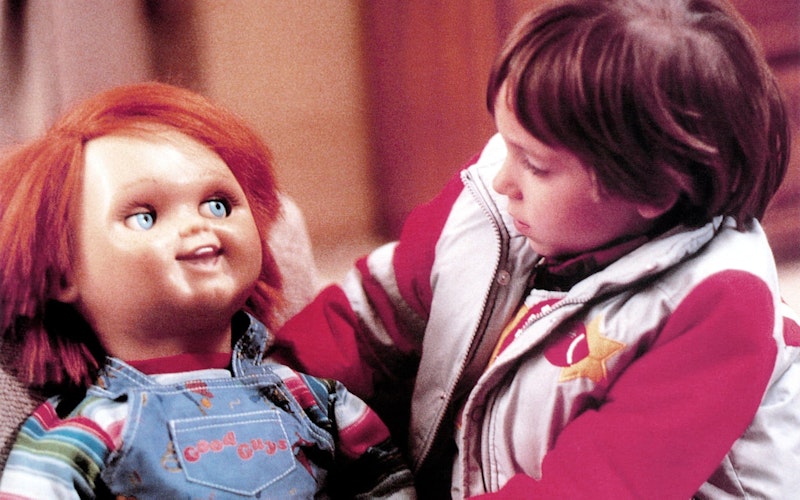
Movies
Child's Play and the Danger of Childish Things
These days, my seven-year-old daughter has only two things on her mind.
One is Chucky, the murderous doll from the Child’s Play franchise, who has stalked her nightmares ever since she saw an online clip from the movie.
The other thing on her mind is salvation. She’s been asking about becoming a Christian, and because I’m more dutiful with her spiritual development than I am her video watching habits, I asked her what she thought that meant.
“A Christian means you don’t sin,” she answered.
When I asked her what a sin is, she explained, “Bad things, like watching bad shows or saying bad words.”
“How does Jesus save you from sins?” I continued.
After thinking about it, she proudly declared, “Jesus makes you good, so you don’t do bad things anymore.”
It’s a childish understanding of the gospel, and my daughter is a child, who needs childish language at this point in her faith. But those concepts have limited use, and if she carried them to adulthood, they could do real damage to herself and others.
Strange as it sounds, there’s overlap between these two obsessions. After all, what are the Child’s Play movies about if not the danger of childish things? The movies have the same basic premise: killer Charles Lee Ray (Brad Dourif), aka Chucky, transfers his soul into a Good Guy doll, to continue his spree undetected, reeking kid-sized carnage.
Like I tell my daughter, Child’s Play is actually pretty silly. After all, Chucky’s only 30 inches tall. He’s easily stopped by an outstretched arm and disposed of with a swift dropkick. To keep the story going, the movies have to keep making new excuses for otherwise reasonable adults to expose themselves to his miniature violence. Even after they realize he’s more than a toy, Chucky’s victims kneel down or turn their back to him, exposing themselves to his six inch stab radius.
But to a kid who spends her life surrounded by toys, nothing’s more frightening than the thought of one coming to life and attacking her. As adults, we remember that feeling of reliance on toys, so that we’re still scared by Child’s Play, despite its wobbly logic.
Simple ideas about sin and judgement are fine for new believers, but they do not properly express the power of the gospel.
No scene in the series captures this better than the first attack in the 1988 original. After putting young Andy Barclay (Alex Vincent) to bed, his babysitter Maggie (Dinah Manoff) hears strange noises throughout the apartment. Cutting between master shots of Maggie moving around the living room, fluid POV shots from Chucky’s perspective, and insert shots of a toy hand holding a kiddie hammer, director Tom Holland builds tension with his rampaging doll, creating a Toys ‘R Us edition of a classic horror movie setup. He does the same with the payoff: in between a POV shot of Maggie as Chucky rushes toward her, and a long take of her falling through a window, Holland shows a tiny hammer striking Maggie’s head.
The image shocks because it transforms an innocent toy into an instrument of destruction. Something that is meant to bring comfort is now a conduit for evil.
New Testament writers knew the power of this effect, often using metaphors about maturity and childhood to warn Christians against complacent thinking, and keep pressing into the difficult parts of Christ’s teaching. After describing Jesus’s submission to God, his forgoing judgment to “deal gently with those who are ignorant and going astray,” the writer of Hebrews pauses to lament those who “no longer try to understand” and urges readers to “move beyond the elementary teachings about Christ and be taken forward to maturity.”
The famous love passage in 1 Corinthians 13 employs a similar theme, with Paul using strong language to add urgency to his argument. Simple ideas about sin and judgement are fine for new believers, but they do not properly express the power of the gospel. Without love and compassion, Christians could unwittingly turn the good news into weapon, using childish logic to terrify others.
The studio behind the 2019 Child’s Play remake have been using that same idea—the dark twisting of innocent, childhood-related imagery—in the new film’s marketing campaign highlighting its June 21st release date, which it shares with Disney’s Toy Story 4. Every week leading to the release, another poster is unveiled of Chucky grinning at a knife protruding from Potato Head or holding a smoking ray gun over the smoldering remains of Buzz Lightyear. The posters are taking characters we loved as children and making them horrific, reminding us that the comfort of childhood nostalgia, and its simplified ideas, can also carry the capacity for horror.
Those images aren’t helping my daughter get over her Chucky-phobia, but they do help remind me of lessons I need to teach her. As she matures, I’ll direct her toward the love she needs to show others and away from the judgment that kills. I’ll help her move past the childish ideas about sin and punishment and toward the love that welcomes and restores.
Topics: Movies